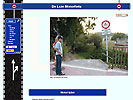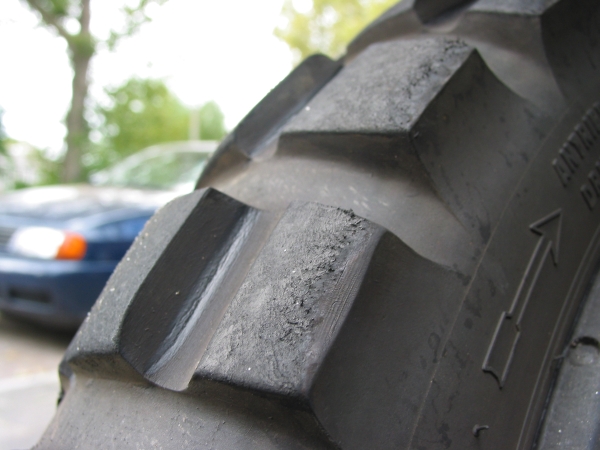
Which pressure should your front and rear tyre have?
What happens if the pressure is too low or too high?
This page has some guidelines and explanations.
![]() Er is een Nederlandse versie:
Er is een Nederlandse versie:
http://www.luiemotorfiets.nl/techniek/bandenspanning/
New tyres, then what?
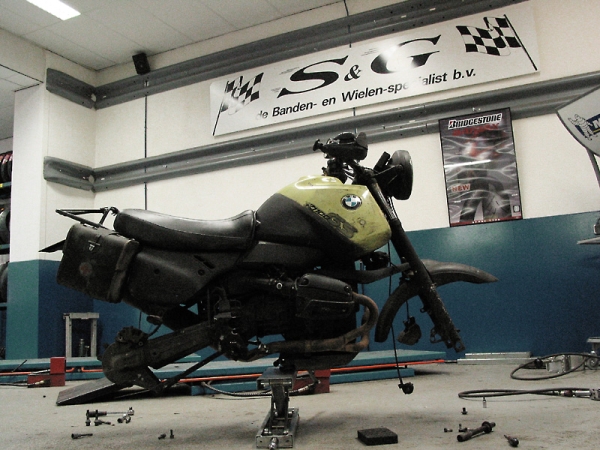
Manual
The most obvious way to determine which tyre pressure you should have in your tyres is, of course, to adhere to the values mentioned in your instruction manual, and start from there.
How you can adjust the tyre pressure to different circumstances is what we will show you further on on this page.
No manual
And what to do if you don't have an instruction manual?
With most motorcycles, a general guideline is to start with:
- 2 atmosphere for the front
- 2.5 atmosphere for the rear
But should the pressure always be the same?
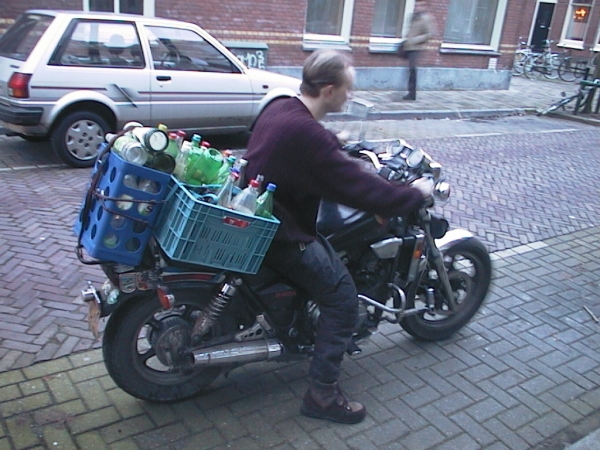
Not everyone uses his or her bike in the same way
Those figures in the instruction manual, or the figures 2 and 2.5, are guidelines. Everybody uses his or her motorcycle in a different way, and different circumstances ask for differences in tyre pressure.
Speed
In short:
- the higher the speed,
- the higher the tyre pressure
Temperature
For temperature the same applies:
- the higher the temperature,
- the higher the tyre pressure
Weight
It's the same with weight:
- the higher the weight,
- the higher the tyre pressure
Surface
The rule for the surface on which you ride sounds as logical:
- the firmer the surface,
- the higher the tyre pressure
It makes even more sense when you realize that a higher tyre pressure creates a harder tyre.
Higher tyre pressure
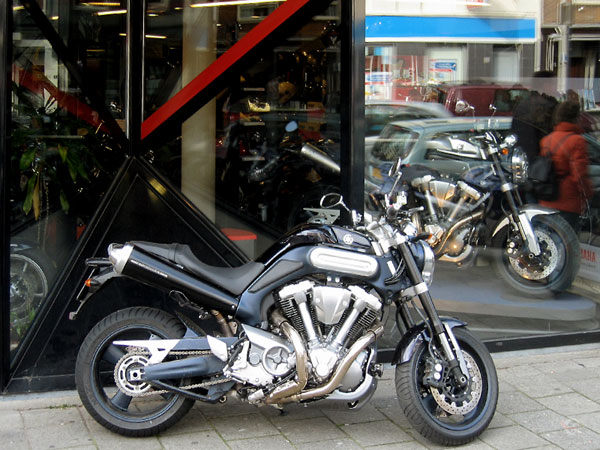
Advantage: economy
A big advantage of a higher tyre pressure is that your fuel economy gets better: the motorcycle will use less fuel. The same applies for the tyres themselves: they will last longer.
So it's cheaper to ride with a higher tyre pressure.
Advantage: firm and sharp
Another advatage is that the bike will feel very sharp in corners, and that you will get a good feedback about the road, from your motorbike.
Disadvantage: grip
One of the disadvantages is that you gave less grip on the road. That's especially true on less than perfect tarmac, because the tyres form, in fact, one of the parts of the damped suspension.
In the same way as with springs that are to tight, the motorcycle will have a tendency to bounce.
Disadvantage: slow warming up
Tyres with a higher tyre pressure take longer to get to the right temperature.
Another disadvantage is that the motorbike will feel harder, and will be less comfortable.
A lower tyre pressure
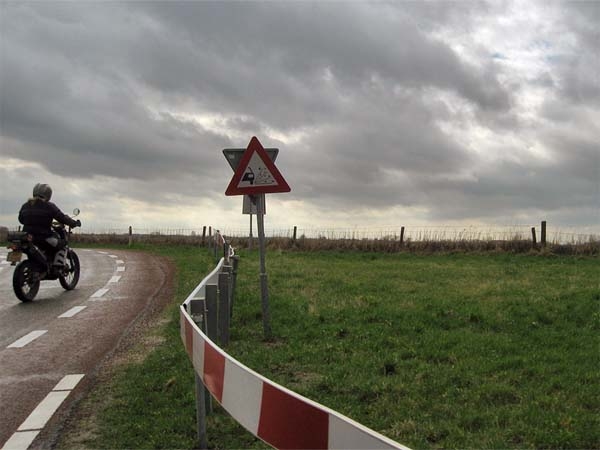
Advantage: warming up
To the opposite, a relatively low tyre pressure means that you will have more grip directly, because the tyres take much less time to warm up.
Advantage: comfortable
A lower tyre pressure is more comfortable, both for the rider and a passenger.
Disadvantage: economy
A disadvantage is that you will use more fuel and more tyres, with a lower pressure.
The tyres not only will wear sooner, but they will alos wear more unevenly (the profile of the tyre will wear like saw-teeth).
Disadvantage: less stability in corners
The downside of tyres warming up more quickly, is that they also can get overheated. The rubber will then desintegrate (which is not good for stability in corners, obviously).
A tyre with a lower pressure can also start to "wring", which also means a less stabel behaviour in corners. You will feel the tyre "walking", and there is a risk to get into a speedwobble.
Tyre pressure when riding off-road
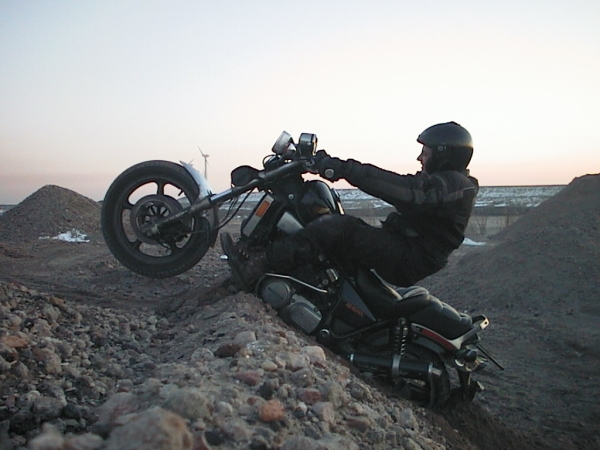
Half of the tyre pressure
If you go out riding off-road (so on a very soft surface), it's very important to halve the tyre pressure.
If you do that, you allow the profile of the tyres to distort to the maximum, which will make that the profile will take the mud or sand between its "fingers", so to speak.
If that is not possible (because the tyre pressure is adjusted to paved roads), then the profile will "rake" through the surface, and because there will be no distortion, it will soon be filled up with mud, which results in tyres that behave as if there is no profile at all.
Advantages
Much grip on a soft surface, a profile which will not get filled up easily, tyres which can climb out of pits or ruts easily.
Disadvantages
A risk of overheating (which is desastrous for the rubber).
Also: the tyre can jump out of the wheel rims if you ride fast corners on tarmac with the tyres still with the pressure for off-road. The knob may tear in the same circumstances.
Tyre clamps
With tube tyres, the valve may tear when you don't use tyre clamps.
In short
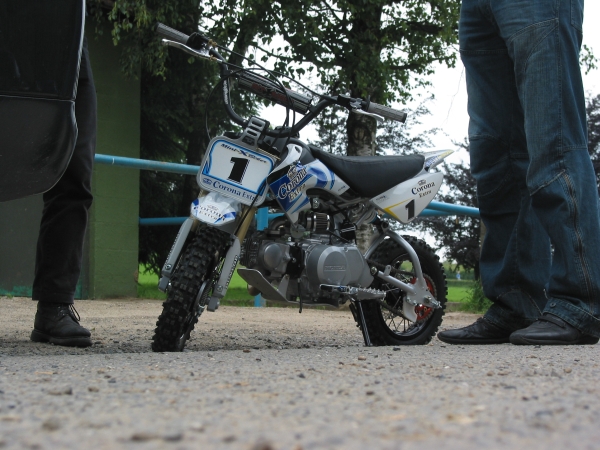
Motorway
A higher tyre pressure gives you a more stable bike, offering more feedback, and using less fuel.
Especially if you ride high mileages on motorways, it is advisable to keep the tyre pressure slightly higher than under ordinary conditions.
A disadvantage is that it takes longer, with low temperatures, before you have the right amount of grip. So be carefull on on- and off-ramps and on roundabouts on the road to the motorway.
The same applies after you have left the motorway: the tyre will cool down easily, so you can be surprised by much less grip than you expected.
Road behaviour
You can influence the behaviour of your bike by playing a bit with the tyre pressure.
You could, for instance, keep a slightly lower pressure in the front (for more grip), and a slightly higher pressure in the rear (for a better economy on motorway stretches).
Extremes
Below the 1 atmosphere, there is a risk opf the tyre running out of its wheel rim.
How to measure the tyre pressure
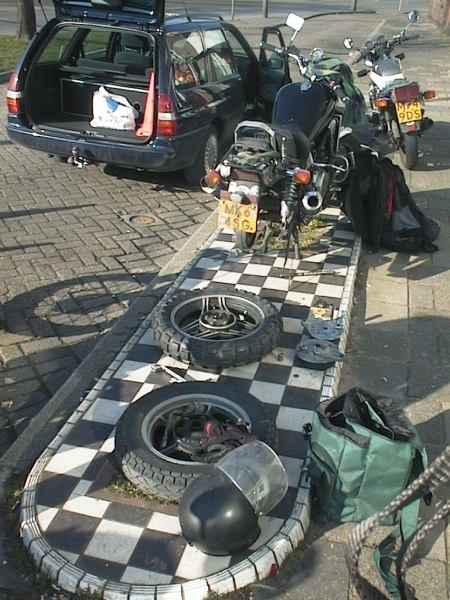
Always the same
It's omportant to measure the pressure with your own gauge. If you don't have your own, always go to the same gas station to use their gauge.
Close after leaving
Preferrably, don't wait longer than 2 kilometers after having left.
The tyre may not be warm (because the pressure will be higher than).
Deviations
Almost every gauge has a deviation. Especially the gauges that you set to a value before you use them ( at gas stations) may have an enormous deviation.
The most reliable gauges are the ones that you have to carry to your bike, with a + and - knob.
Of course, some motorbikes have a display that always shows the tyre pressure.
Comments, Q & A, on a separate page




